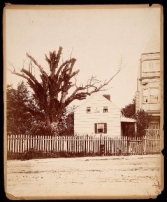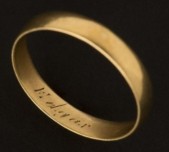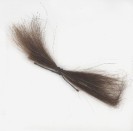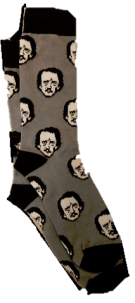Many of the objects on display at the George Peabody Library in the exhibition The Enigmatic Edgar A. Poe in Baltimore & Beyond, were somehow related to Poe’s literature. The display consisted primarily of his own manuscripts, published copies of his works, and interpretations of his writing in songs and images.
This collection of objects specifically highlights Edgar Allan Poe’s life (and his life after death) as not just as an author, but as a person. These seven objects represent Poe as more than a writer; they portray him in his life outside of his writing. They provide us with concrete objects that played a role in his life and show some of its major events: his home, his proposal, his death. They convey a sense of ‘realness’ for the viewer, reminding us that he was not just a name on a page, but a genuine person with a life outside of his writing.
Five of these seven objects were on display recently at the George Peabody Library in Baltimore, in the exhibition The Enigmatic Edgar A. Poe in Baltimore & Beyond. The last two objects I choose from my own collection of Poe paraphernalia.
Who was the man behind the manuscript?
After his death, Poe gained a fan club of literary enthusiasts (including myself) who view him as a celebrity. To historians, every aspect of his life mattered and should be archived, and I personally find it amazing that we have objects that he himself touched! Many objects from his life were saved and can be seen as ‘clues’ into his real life, beyond the persona he created through his writing on the page.

-
Edgar Allan Poe, letter to James Russell Lowell, November 24, 1842, Philadelphia. From the Susan Jaffe Tane Collection.
Poe’s Lifetime – The Letter, The Photograph, The Ring

R. F. Turnbull, Poe’s Fordham. New York cottage, Photograph, circa 1880s. From the Susan Jaffe Tane Collection
These first three objects help us visualize Poe during the time he
was alive, and remind us of what his life was like outside of his writing career. When I think of Poe, I immediately recall his short stories and his poems. But not only did Poe write
creatively, he also wrote critical analyses and reviews, and in his free time from work, he wrote personal letters. Although this letter to James Russell Lowell was probably never meant to be published or displayed as it is now, we can still see the

-
Gold engagement ring, engraved “Edgar,” manufacturer unknown. Given by Poe to Elmira Royster Shelton in Richmond, 1849. From the Susan Jaffe Tane Collection.
eloquence of his writing and his way with words – even when not intentionally attempting to sound poetic! But we also care about and are interested in his family, friends, and life outside of writing. The photograph allows us to see New York as Poe would have seen his home, and imagine the author living in that house. We can even imagine him picking out the ring to give to Elmira Shelton and engraving it with his love for her. Just thinking that this was a ring that was once held by Poe gives it a sense of significance and realness that his manuscripts might not allow.
Poe’s Death – His Hair, His Coffin

Lock of Edgar Allan Poe’s hair, clipped at his death, 1849. From the Susan Jaffe Tane Collection.
These two objects also evoke a sense of realness by pertaining to his physical death. Sometimes I get so immersed in a writer’s works that I

-
Fragment of Poe’s coffin with receipt, 1849. Retrieved when his remains were relocated in 1875. From the Susan Jaffe Tane Collection.
forget whether the real person is currently alive or dead, and these objects serve to remind us that we will never meet him in person. The unique physicality of his lock of hair and the fragment of his coffin remind us that he is physically dead, even though he seems to live on when we read his writing. A bit of wood does not have significance on its own, but when we’re told it is part of Poe’s coffin, we view it in awe. Much of Poe’s life is still a mystery, especially his death, and the objects concerning his death are especially poignant when we realize we still can only hypothesize about the cause of his death.
Poe’s Afterlife – The Sticker, The Socks

Poe for President “Make America Read Again” sticker, from the Baltimore Book Festival, 2016. Given out by Poe Forevermore Magazine, published by Mark Redfield. Baltimore.
The last two objects pertain to Poe’s life after death – his life of fame. While Poe the living man is now dead, Poe the author lives on in his works and in his persona. But we idolize Poe in his literary afterlife not just as a writer, or a poet, or an author, but as a man whom we celebrate for every aspect of his life.
The sticker and the socks take the concept of Poe and commercialize it. This is many steps removed from his writing; Poe is one of few authors that is

“Edgar Allan Poe-ka Dots Socks,” bought online from Out of Print Clothing Inc., 2016.
celebrated not just for his literary works, but for his existence as a person. Both these objects do not even mention his literature, but rather market on the alliteration and puns that can be made with his name, and the popularity surrounding the idea of Poe as a mysterious person and a parody of himself.
Poe is remembered and honored both as an author and as an interesting, mysterious person, and not many writers are remembered for more than their writing.